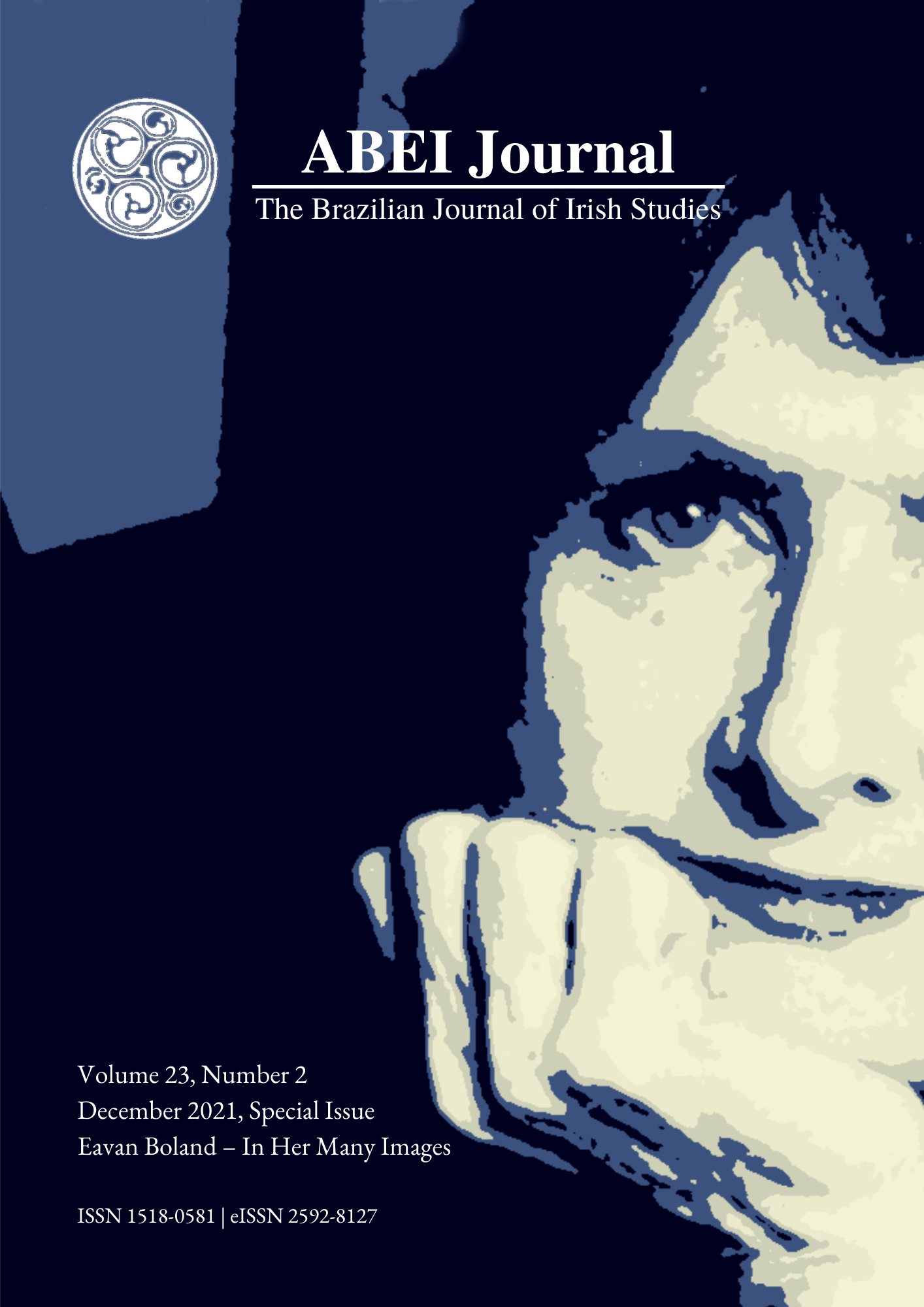Queer Phenomenology and the Things Themselves in Eavan Boland’s In a Time of Violence
DOI:
https://doi.org/10.37389/abei.v23i2.197752Keywords:
Eavan Boland, Poetry, Queer Phenomenology, Sara Ahmed, EkphrasisAbstract
Situating Eavan Boland’s In a Time of Violence in dialogue with Sara Ahmed’s Queer Phenomenology, this article contends that Boland’s ekphrastic portrayals of physical things queers both traditional phenomenological conceptions of being-in-the-world as well as numerous conventions in Irish poetry. Eavan Boland’s concern for objects throughout the volume undermines widespread literary depictions of Irish women as essentialized, mythologized, or emblematized figures. Her preoccupation with physical things allows her to reject acts of reductive, discursive violence so often perpetrated by past male Irish authors and poets. Boland chooses to focalize upon quotidian, pedestrian, and overlooked objects, thus naturally aligning her poetry with Sara Ahmed’s Queer Phenomenology. Both Boland and Ahmed rescue marginalized perspectives from the darkened corners of existence. Boland’s poetry demonstrates an acute awareness that returning to “the things themselves” (Husserl 18) provides avenues for reclamation, multiplicity, and autonomy in the face of hegemonic, anonymizing narratives of Irish femininity.
References
Ahmed, Sara. Queer Phenomenology: Orientations, Objects, Others. Duke University Press, 2006.
Boland, Eavan. “A Woman Painted on a Leaf.” In a Time of Violence. 1st ed, Norton, 1994, p. 69.
Boland, Eavan. “In a Bad Light.” In a Time of Violence. 1st ed, Norton, 1994, pp. 12–13.
Boland, Eavan. “Story.” In a Time of Violence. 1st ed, Norton, 1994, pp. 61–62.
Boland, Eavan. “The Parcel” In a Time of Violence. 1st ed, Norton, 1994, pp. 44–45.
Boland, Eavan. “What Language Did.” In a Time of Violence. 1st ed, Norton, 1994, pp. 63–65.
Boland, Eavan. “Outside History.” Object Lessons: The Life of the Woman and the Poet in Our Time. W.W. Norton, 1996.
Collins, Lucy. Contemporary Irish Women Poets: Memory and Estrangement. Liverpool University Press, 2015.
Cory, Abbie L. “‘This Is a Stitch’: Gender, Class, and Colony in the Poetry of Eavan Boland.” Women’s Studies, vol. 43, no. 7, Oct. 2014, pp. 960–78.
Craps, Stef. “‘Only Not beyond Love’: Testimony, Subalternity, and the Famine in The Poetry of Eavan Boland.” Neophilologus, vol. 94, no. 1, Sept. 2009, p. 165.
Gonzalez, Alexander G. “Eavan Boland’s ‘The Glass King’ and R. G. Collingwood’s Theory of Art.” South Atlantic Review, vol. 76, no. 4, South Atlantic Modern Language Association, 2011, pp. 143–53.
Heidegger, Martin. Being and Time: A Translation of Sein Und Zeit. State University of New York Press, 1996.
Hopp, Walter. Phenomenology: A Contemporary Introduction. Routledge, 2020.
Husserl, Edmund. Ideas Pertaining to a Pure Phenomenology and to a Phenomenological Philosophy. Kluwer Academic Pub., 1983.
Kearney, Richard, and Kascha Semonovitch, editors. Phenomenologies of the Stranger: Between Hostility and Hospitality. 1st ed, Fordham University Press, 2011.
Kidd, Helen. “Cailleachs, Keens and Queens: Reconfiguring Gender and Nationality in the Poetry of Eileán Ni Chuilleanáin, Nuala Ní Dhomhnaill and Eavan Boland.” Critical Survey, vol. 15, no. 1, Berghahn Books, 2003, pp. 34–47.
LeBouef, Tawny O. “(Re)Possessing Historical Perception through Poetic Voice: A Phenomenological Study of the Poetry of Eavan Boland.” Dissertation, Texas Woman’s University.
Longley, E. The living stream: Literature and revisionism in Ireland. Newcastle: Bloodaxe, 1994.
Meaney, Gerardine. “Myth, History and the Politics of Subjectivity: Eavan Boland and Irish Women’s Writing.” Women: A Cultural Review, vol. 4, no. 2, Routledge, Sept. 1993, pp. 136–53.
Merleau-Ponty, Maurice. Phenomenology of Perception. Translated by Colin Smith, Routledge, 2005.
Murata, Junichi. “Colours and Sounds: The Field of Visual and Auditory Consciousness.” Zahavi, Dan, editor. The Oxford Handbook of Contemporary Phenomenology. 1st ed, Oxford University Press, 2012.
Raschke, D. “Eavan Boland’s Outside History and In a Time of Violence: Rescuing Women, the Concrete, and Other Things Physical from the Dung Heap.” Colby Quarterly, vol. 32, no. 2, Colby College Library., Jan. 1996, pp. 135–42.
Riley, Jeannette E. “‘Becoming an Agent of Change’: Eavan Boland’s ‘Outside History’ and ‘In a Time Of Violence.’” Irish Studies Review, vol. 5, no. 20, Routledge, Sept. 1997, pp. 23–29.
Spivak, Gayatri. “Can the Subaltern Speak?” Marxism and the Interpretation of Culture. Nelson, Cary, editor. Macmillan Education, 1988.
Villar-Argáiz, Pilar. “Recording the Unpoetic: Eavan Boland’s Silences.” Irish University Review, vol. 37, no. 2, Edinburgh University Press, 2007, pp. 472–91.
Walter, Katharina. “From Aisling to Chora: Female Allegories of the Nation in Contemporary Irish Women’s Poetry.” Irish Studies Review, vol. 21, no. 3, Aug. 2013, pp. 313–25.
Downloads
Published
Issue
Section
License
Copyright (c) 2021 Aubry Haines

This work is licensed under a Creative Commons Attribution-NonCommercial 4.0 International License.


